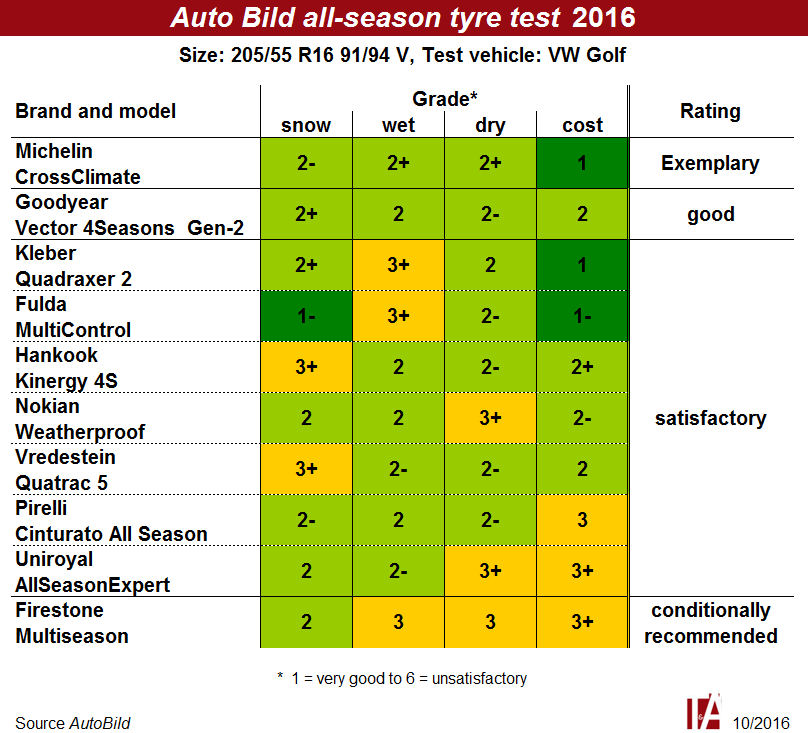Summer tyre wins all-season test

The results table for the 2016 Auto Bild all-season tyre test saw last year’s winner and runner-up – the Goodyear Vector 4Seasons and Michelin CrossClimate – swap places. This occurrence means that this year’s size 205/55 R16 all-season tyre test was in fact won by a summer tyre, as Michelin considers its CrossClimate a summer fitment designed and legally approved for year-round use. Call it what you like, at any rate the Auto Bild team deemed the Michelin CrossClimate the pick of the ten-tyre bunch, and awarded it the test’s only ‘exemplary’ rating.
Auto Bild described the CrossClimate as an “exemplary all-rounder with the best driving characteristics on wet and dry surfaces,” although braking distance on snow was slightly on the long side. The tyre’s precise steering response and good mileage also gained a mention, and this last quality helped the Michelin rubber win the additional status of ‘eco champion’, a title it shared with the third-placed Quadraxer 2, a tyre produced by Michelin-owned brand Kleber. “The best mileage was shown by the Michelin and Kleber tyres: More than 55,000 kilometres should be possible with these,” commented Auto Bild tyre tester Dierk Möller. He added that even though the Michelin tyres were the most expensive set in the test, their low rate of wear demonstrates that fitting premium-priced all-season tyres can be economically viable.
The Goodyear tyre, now in its second generation, also gave a convincing performance thanks to a combination of its admirable winter characteristics and good stopping distance on wet road surfaces. Its “lengthy dry braking distance” was viewed as a weakness, however. The Quadraxer 2 was denied a higher spot on the table due to just average lateral control in the wet; this drawback aside, the Kleber rubber was characterised as an all-round talent that offered the greatest value for money, a product with short wet and dry braking distances, high mileage and a low price.
Fourth and fifth place were respectively occupied by the Fulda MultiControl and Hankook Kinergy 4S. The Fulda tyre was praised for its strong performance in the snow, stable wet and dry handling, high level of comfort and its value for money, however it drew criticism for wet braking distance. The Kinergy 4S was also marked down for its wet braking distance and additionally for its “limited winter suitability,” yet gained points for harmonious steering response, dynamic handling in the wet and good value for money.
The Nokian Wealtherproof finished in sixth place, and on the one hand was seen as offering a good balance of performance, particularly safe driving characteristics on snow-covered surfaces and good resistance to aquaplaning. Yet the Weatherproof was let down by its wet and dry braking performance, as well as its handling in the dry, which was punctuated by understeering. Finishing behind it in seventh place was the Vredestein Quattrac 5, and the testers listed its weaknesses as “undistinguished snow characteristics and lengthy dry braking distance,” however they also credited the tyre with providing harmonious handling performance in all weather conditions, along with good value for money.
Eighth place was occupied by the Pirelli Cinturato All Season. While Auto Bild described the Pirelli rubber as offering “good winter qualities, high safety reserves in aquaplaning” and low rolling noise, the other side of the Cinturato All Season scale was weighed down by only “average lateral control on wet and dry surfaces,” while mileage was also deemed to be on the low side. The Uniroyal AllSeasonExpert finished in ninth place and was credited with coming to a quick stop in snow and for giving high levels of aquaplaning safety, positive characteristics paired with understeering in the wet and dry and a lengthy wet and dry braking distance.
The tyres finishing in third to ninth place all received a rating of ‘satisfactory’, however the wooden spoon recipient in this year’s test didn’t. The Firestone Multiseason was given a ‘conditionally recommended’ rating for its performance, which included good qualities in the snow on the one hand, but also a number of negative characteristics, including understeer on wet and dry road surfaces and “noticeably lengthy wet and dry braking distances.”



Comments